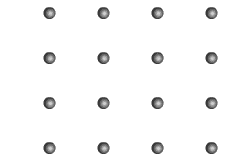bcs01 BCS Theory of Superconductivity
BCS Theory of Superconductivity
An intuitive description of superconductivity is sufficient for public and non-technical uses. However, ultimately, a more rigorous mathematically- based explanation must be formulated. Superconductivity was not sufficiently explained until 1957 when John Bardeen and his graduate assistants Leon Cooper and John Schreiffer proposed a microscopic explanation that would later be their namesake: the BCS Theory. This theoretical explanation later earned them the Nobel prize, making John Bardeen the only man in history to be awarded this honor twice.
The BCS Theory is, in its simplest form, actually contradictory to our crude macroscopic view expressed earlier. As discussed earlier, superconductivity arises because electrons do not interact destructively with atoms in the crystal lattice of the material. The BCS Theory says that electrons do actually interact with the atoms, but constructively.
The BCS Theory makes a crucial assumption at the beginning: that an attractive force exists between electrons. In typical Type I superconductors, this force is due to Coulomb attraction between the electron and the crystal lattice. An electron in the lattice will cause a slight increase in positive charges around it. This increase in positive charge will, in turn, attract another electron. These two electrons are known as a Cooper pair. If the energy required to bind these electrons together is less than the energy from the thermal vibrations of the lattice attempting to break them apart, the pair will remain bound. This explains (roughly) why superconductivity requires low temperatures- the thermal vibration of the lattice must be small enough to allow the forming of Cooper pairs. In a superconductor, the current is made up of these Cooper pairs, rather than individual electrons.
So, Cooper pairs are formed by Coulomb interactions with the crystal lattice. This is also what overcomes resistance. Remember, an electron inside the lattice causes a slight increase of positive charge due to Coulomb attraction. As the Cooper pair flows, the leading electron causes this increase of charge, and the trailing electron is attracted by it. This is illustrated below.

This BCS theory prediction of Cooper pair interaction with the crystal lattice has been verified experimentally by the isotope effect. That is, the critical temperature of a material depends on the mass of the nucleus of the atoms. If an isotope is used (neutrons are added to make it more massive), the critical temperature decreases. This effect is most evident in Type I, and appears only weakly in Type II.
"...recall that early researchers made the somewhat paradoxical observation that the best conducting materials could not be made to exhibit superconductivity. A good conductor is, by definition, a material that will allow electrons to carry current with a minimum resistance. Therefore, since the primary cause of resistance is the electrons collisions with the lattice, a good conductor must have a minimal interaction between the electrons and the lattice. Consequently, the lattice is unable to mediate an attractive force between the electrons and the superconducting phase transition cannot occur. The converse of this observation also holds: metals exhibiting poor conductivity make excellent superconductors with relatively higher critical temperatures because the electrons greatly interact with the lattice." (Orlando 527)
This superconductivity of Cooper pairs is somewhat related to Bose-Einstein Condensation. The Cooper pairs act somewhat like bosons, which condense into their lowest energy level below the critical temperature, and lose electrical resistance.
The BCS Theory did exactly what a physical theory should do: it explained properties already witnessed in experiment, and it predicted experimentally verifiable phenomena. Though its specific quantitative elements were quite limited in their application (it only explained Type I s-wave superconductivity), its essence was quite broad and has been modified applied to various other superconductors, such as Type II perovskites.
Main / Introduction / BCS Theory / Type II / Practicality / Exotic / Ferromagnetic / Applications / Sources
No comments:
Post a Comment